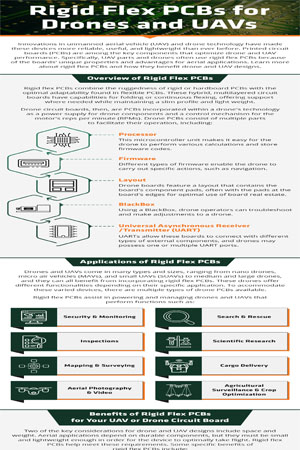Innovations in unmanned aerial vehicle (UAV) and drone technology have made these devices more reliable, useful, and lightweight than ever before. Printed circuit boards (PCBs) are among the key components that optimize drone and UAV performance. Specifically, UAV parts and drones often use rigid flex PCBs because of the boards’ unique properties and advantages for aerial applications. Learn more about rigid flex PCBs and how they benefit drone and UAV designs.
Overview of Rigid Flex PCBs
Rigid flex PCBs combine the ruggedness of rigid or hardboard PCBs with the optimal adaptability found in flexible PCBs. These hybrid, multilayered circuit boards have capabilities for folding or continuous flexing, offering support where needed while maintaining a slim profile and light weight.
Drone circuit boards, then, are PCBs incorporated within a drone’s technology as a power supply for drone components and a control mechanism for the motor’s reps per minute (RPMs). Drone PCBs consist of multiple parts to facilitate their operation, including:
- Processor. This microcontroller unit makes it easy for the drone to perform various calculations and store firmware codes.
- Firmware. Different types of firmware enable the drone to carry out specific actions, such as navigation.
- Layout. Drone boards feature a layout that contains the board’s component pads, often with the pads at the board’s edges for optimal use of board real estate.
- Universal Asynchronous Receiver/Transmitter (UART). UARTs allow these boards to connect with different types of external components, and drones may possess one or multiple UART ports.
- BlackBox. Using a BlackBox, drone operators can troubleshoot and make adjustments to a drone.
Drone PCBs can allow UAV manufacturers the innovative capability to minimize the space between the board’s components and reduce the board’s weight, and rigid flex PCBs enable this compact precision.
How Rigid Flex PCBs Meet Avionic Specifications
Rigid flex PCBs offer numerous benefits for a variety of drone- and UAV-related applications.
Applications of Rigid Flex PCBs
Drones and UAVs come in many types and sizes, ranging from nano drones, micro air vehicles (MAVs), and small UAVs (SUAVs) to medium and large drones, and they can all benefit from incorporating rigid flex PCBs. These drones offer different functionalities depending on their specific application. To accommodate these varied devices, there are multiple types of drone PCBs available. For example, quadcopter controller boards or quadcopter PCBs help control this four-rotor type of drone. Mini drone circuit boards work within compact versions of standard drones.
Rigid flex PCBs assist in powering and managing drones and UAVs that perform functions such as:
- Security and monitoring
- Search and rescue
- Inspections
- Scientific research
- Mapping and surveying
- Cargo delivery
- Aerial photography and video
- Agricultural surveillance and crop optimization
Benefits of Rigid Flex PCBs for Your UAV or Drone Circuit Board
Two of the key considerations for drone and UAV designs include space and weight. Aerial applications depend on durable components, but they must be small and lightweight enough in order for the device to optimally take flight. Rigid flex PCBs help meet these requirements. Some specific benefits of rigid flex PCBs include:
- Space optimization. Rigid flex PCBs are compact yet feature sufficient surface area to hold all board components, including all required cables and connectors. This design helps eliminate the need for additional PCBs to accommodate more components.
- Reduced weight. These PCBs help reduce the overall weight of drone boards because of their small size and lightweight design. It’s also possible to manufacture PCBs with ultra-thin dielectrics that further reduce the board’s weight, allowing for increased fuel efficiency and overall performance.
- Vibration and shock resistance. Many electronics applications that require components with high endurance use rigid flex PCBs because of their ability to withstand environments with high levels of vibration or shock.
- Flexibility. Manufacturers can configure these flexible PCBs to fit into tight spaces. Rigid flex PCBs also offer flexibility of design as, due to their size and ability to work in small areas, manufacturers do not have to take a “circuitry first” approach for electronic devices.
- Customizability. With a high capacity for customization, rigid flex PCBs can offer compatibility with various features and processes, including the UAV or drone’s motor, remote control operation, and GPS capabilities.
- Shielding. Motors and other devices in UAVs generate electromagnetic waves that can interfere with video feeds. Rigid flex PCBs can easily incorporate shielding of the circuitry within the flex layers, protecting them from electromagnetic interference.
Rigid flex PCBs offer dependable performance while optimizing the space within a drone or UAV device. The opportunities they provide for customization lend them high versatility throughout the UAV technological sector.

